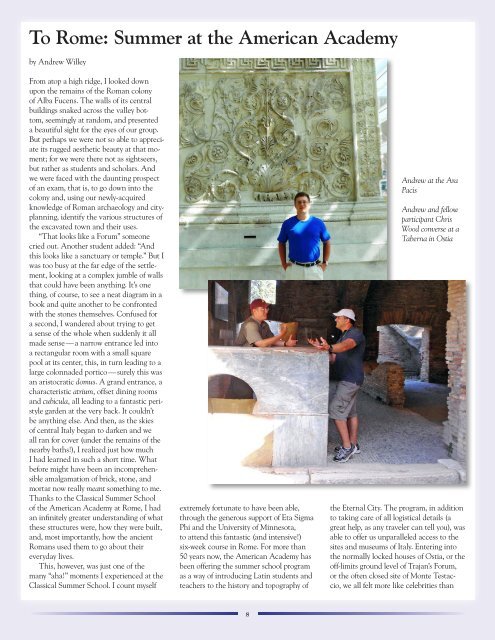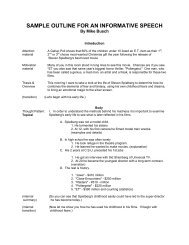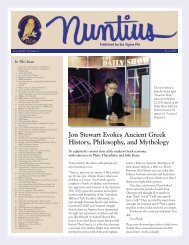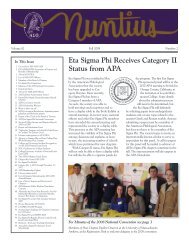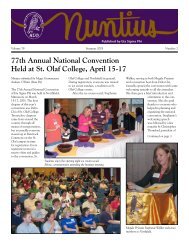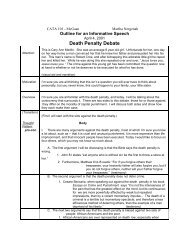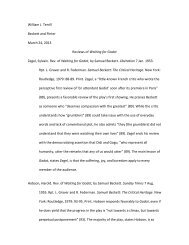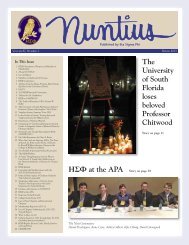In the Land of the Sibyl - Monmouth College
In the Land of the Sibyl - Monmouth College
In the Land of the Sibyl - Monmouth College
You also want an ePaper? Increase the reach of your titles
YUMPU automatically turns print PDFs into web optimized ePapers that Google loves.
To Rome: Summer at <strong>the</strong> American Academy<br />
by Andrew Willey<br />
From atop a high ridge, I looked down<br />
upon <strong>the</strong> remains <strong>of</strong> <strong>the</strong> Roman colony<br />
<strong>of</strong> Alba Fucens. The walls <strong>of</strong> its central<br />
buildings snaked across <strong>the</strong> valley bottom,<br />
seemingly at random, and presented<br />
a beautiful sight for <strong>the</strong> eyes <strong>of</strong> our group.<br />
But perhaps we were not so able to appreciate<br />
its rugged aes<strong>the</strong>tic beauty at that moment;<br />
for we were <strong>the</strong>re not as sightseers,<br />
but ra<strong>the</strong>r as students and scholars. And<br />
we were faced with <strong>the</strong> daunting prospect<br />
<strong>of</strong> an exam, that is, to go down into <strong>the</strong><br />
colony and, using our newly-acquired<br />
knowledge <strong>of</strong> Roman archaeology and cityplanning,<br />
identify <strong>the</strong> various structures <strong>of</strong><br />
<strong>the</strong> excavated town and <strong>the</strong>ir uses.<br />
“That looks like a Forum” someone<br />
cried out. Ano<strong>the</strong>r student added: “And<br />
this looks like a sanctuary or temple.” But I<br />
was too busy at <strong>the</strong> far edge <strong>of</strong> <strong>the</strong> settlement,<br />
looking at a complex jumble <strong>of</strong> walls<br />
that could have been anything. It’s one<br />
thing, <strong>of</strong> course, to see a neat diagram in a<br />
book and quite ano<strong>the</strong>r to be confronted<br />
with <strong>the</strong> stones <strong>the</strong>mselves. Confused for<br />
a second, I wandered about trying to get<br />
a sense <strong>of</strong> <strong>the</strong> whole when suddenly it all<br />
made sense — a narrow entrance led into<br />
a rectangular room with a small square<br />
pool at its center, this, in turn leading to a<br />
large colonnaded portico — surely this was<br />
an aristocratic domus. A grand entrance, a<br />
characteristic atrium, <strong>of</strong>fset dining rooms<br />
and cubicula, all leading to a fantastic peristyle<br />
garden at <strong>the</strong> very back. It couldn’t<br />
be anything else. And <strong>the</strong>n, as <strong>the</strong> skies<br />
<strong>of</strong> central Italy began to darken and we<br />
all ran for cover (under <strong>the</strong> remains <strong>of</strong> <strong>the</strong><br />
nearby baths!), I realized just how much<br />
I had learned in such a short time. What<br />
before might have been an incomprehensible<br />
amalgamation <strong>of</strong> brick, stone, and<br />
mortar now really meant something to me.<br />
Thanks to <strong>the</strong> Classical Summer School<br />
<strong>of</strong> <strong>the</strong> American Academy at Rome, I had<br />
an infinitely greater understanding <strong>of</strong> what<br />
<strong>the</strong>se structures were, how <strong>the</strong>y were built,<br />
and, most importantly, how <strong>the</strong> ancient<br />
Romans used <strong>the</strong>m to go about <strong>the</strong>ir<br />
everyday lives.<br />
This, however, was just one <strong>of</strong> <strong>the</strong><br />
many “aha!” moments I experienced at <strong>the</strong><br />
Classical Summer School. I count myself<br />
extremely fortunate to have been able,<br />
through <strong>the</strong> generous support <strong>of</strong> Eta Sigma<br />
Phi and <strong>the</strong> University <strong>of</strong> Minnesota,<br />
to attend this fantastic (and intensive!)<br />
six-week course in Rome. For more than<br />
50 years now, <strong>the</strong> American Academy has<br />
been <strong>of</strong>fering <strong>the</strong> summer school program<br />
as a way <strong>of</strong> introducing Latin students and<br />
teachers to <strong>the</strong> history and topography <strong>of</strong><br />
Andrew at <strong>the</strong> Ara<br />
Pacis<br />
Andrew and fellow<br />
participant Chris<br />
Wood converse at a<br />
Taberna in Ostia<br />
<strong>the</strong> Eternal City. The program, in addition<br />
to taking care <strong>of</strong> all logistical details (a<br />
great help, as any traveler can tell you), was<br />
able to <strong>of</strong>fer us unparalleled access to <strong>the</strong><br />
sites and museums <strong>of</strong> Italy. Entering into<br />
<strong>the</strong> normally locked houses <strong>of</strong> Ostia, or <strong>the</strong><br />
<strong>of</strong>f-limits ground level <strong>of</strong> Trajan’s Forum,<br />
or <strong>the</strong> <strong>of</strong>ten closed site <strong>of</strong> Monte Testaccio,<br />
we all felt more like celebrities than<br />
8


